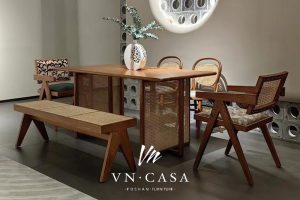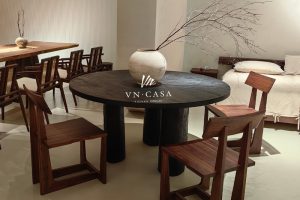Timeless Charm: A Journey Through Traditional Chinese Furniture

Picture a room where every piece tells a story. Wood gleams with age-old craftsmanship. Curves flow like rivers in a painting. That’s the magic of traditional Chinese furniture. It draws you in, blending history with quiet beauty. For homeowners worldwide, it offers more than decor. It brings calm and depth to daily life.
In a world of fast trends, these pieces stand firm. They root your space in something real. Maybe you’re revamping a living area or hunting for that one standout chair. Traditional Chinese furniture fits right in. It mixes with modern setups, adding warmth without clutter. And sourcing it? That’s where real adventure begins.
This guide walks you through its past, standout traits, and ways to make it yours. You’ll see why it lasts. And how it can shape your home.
The Deep Roots of Traditional Chinese Furniture
Traditional Chinese furniture didn’t pop up overnight. It grew over thousands of years, shaped by daily needs and big shifts in society. Back in ancient times, people sat on mats. Furniture was simple—low stools or wide benches. But as life changed, so did the designs.
Think about it. Early makers used what was around: bamboo for lightness, wood for strength. They built frames that locked together, no nails needed. This skill came from building homes and temples. It made furniture tough yet graceful.
Today, we chase that same balance. A table that holds family meals. A bed that cradles rest. Traditional Chinese furniture nails it. Its origins remind us: good design serves people first.
Tracing Back to the Earliest Days
Go back to the Xia and Shang dynasties, around 2000 BC. Furniture was basic then. Couches for lounging. Simple cabinets for storage. Lacquer coated surfaces for shine and protection. Folks even inlaid ivory or jade for a touch of luxury.
Life moved slow. People knelt or sat cross-legged. So pieces stayed low to the ground. But tools improved—saws, chisels from better metalwork. Legend says Lu Ban, a master craftsman, sparked big leaps. He pushed folks to think smarter about wood.
These early steps set the tone. Strength met subtle art. No flash, just solid form. It’s why old pieces feel fresh now. They whisper of quiet lives, full of care.
How Dynasties Shaped Traditional Chinese Furniture

China’s history unfolds like a scroll. Each era added layers to furniture. From rough starts to golden peaks, designs evolved. Wars, trade, even faith played parts. Buddhism brought lotus motifs. Silk Road swaps added new woods.
By the Tang Dynasty, styles split: low for everyday, high for elites. Ming brought clean lines. Qing piled on details. Each wave built on the last. The result? A rich mix anyone can draw from.
What pulls you to it? Maybe the history. Or the way it fits any room. Let’s break it down by key times.
Shifts from Low to High Forms
In the Spring and Autumn and Warring States periods, around 700 BC, low furniture ruled. Short legs kept things close to earth. Metal tools made carving easier. Saws cut precise joints. Drills added holes for inlays.
Qin and Han eras raised the bar—literally. Legs grew taller. Influences from the West crept in. Desks stood higher. Beds got frames. Sitting straight became the norm. No more floor huddles.
Wei, Jin, and later dynasties sealed the change. Chairs emerged. Backs curved for comfort. Lotus carvings nodded to new beliefs. High forms spread. They suited bigger homes, busier lives.
This rise mirrored society. More trade, more movement. Furniture adapted. It stayed useful, but gained poise.
The Golden Age: Ming and Qing Eras
Ming Dynasty, 14th to 17th century—that’s peak time. Lines turned simple, elegant. Hardwoods like rosewood shone. Joints fit like puzzles, no glue. Chairs with humpback backs. Tables with cabriole legs.
Craftsmen chased balance. No overdone carvings. Just smooth grains and subtle shapes. It felt alive, like nature itself.
Qing followed, 17th to early 20th century. More flair here. Emperors wanted grandeur. Inlays of mother-of-pearl. Lacquer in bold reds. Materials expanded—ebony, even cork for bounce.
Peak came under Qianlong. Variety exploded. But Ming’s clean spirit lingered. Qing pieces dazzle, yet root in that base.
Together, these eras define traditional Chinese furniture. Ming for purity. Qing for richness. Both teach: beauty hides in craft.
|
Dynasty |
Key Shift |
Standout Trait |
Example Piece |
|
Shang/Zhou |
Low, basic forms |
Lacquer finishes |
Low stools |
|
Qin/Han |
Taller legs |
Western influences |
Framed beds |
|
Tang |
Mix of high/low |
Floral carvings |
Lotus chairs |
|
Ming |
Elegant simplicity |
Mortise joints |
Humpback chairs |
|
Qing |
Ornate details |
Inlaid gems |
Lacquered cabinets |
This table shows the flow. Each step built stronger roots.
What Sets Traditional Chinese Furniture Apart
Spot traditional Chinese furniture in a crowd. It’s the poise. The way wood warms a space. Materials matter: elm for everyday toughness, huanghuali for rare glow.
Designs draw from nature. Clouds in curves. Mountains in sturdy bases. Multi-use shines— a bench that stores, a screen that divides.
Function leads. Pieces fit bodies right. Chairs hug the back. Tables reach easy heights. Art follows. Carvings tell tales, but never steal the show.
In homes today, this mix wins. It calms busy minds. Adds layers without noise.
- Natural Flow: Curves mimic rivers, easing the eye.
- Hidden Strength: Joints lock tight, lasting generations.
- Story in Every Grain: Woods from old forests carry whispers of time.
These traits make it timeless. Not just stuff—it’s legacy.
Materials That Tell Tales
Woods vary by region. Northern elm handles cold. Southern rosewood fights humidity. Bamboo bends, never breaks—light for screens or chairs.
Lacquer seals it all. Reds from minerals. Blacks from soot. It guards against wear, adds depth.
Inlays jazz things up. Shell for shimmer. Metal for edge. But always balanced. No overload.
Choose right, and your piece lasts. It ages like wine, gaining patina.
The Lasting Pull of Traditional Chinese Furniture in Modern Homes
Why go traditional now? Life rushes. These pieces slow it down. They ground you. In a minimalist flat or cozy villa, they fit.
Global tastes lean East. Zen vibes meet bold statements. A Ming chair beside a sleek sofa? It works. Blends old wisdom with new ease.
Care to the culture too. Owning it links you to China’s heart. Trade routes, dynasties—all in one table.
For families, it’s heirloom potential. Kids grow, pieces stay. Stories pass on.
Cultural Depth That Resonates
Beyond looks, it’s soul. Furniture held rituals—tea chats on benches. Weddings under carved beds. It wove into festivals, daily rites.
Buddhist influence? Lotus blooms in legs. Confucian order? Symmetrical lines.
This depth enriches homes. Not just pretty. It’s thoughtful.
Fitting It Into Everyday Spaces
Start small. A side table in the hall. Builds from there.
Mix smart. Pair with glass for contrast. Or layer with textiles for warmth.
Scale matters. Measure twice. Traditional sizes suit open plans.
Light it soft. Let wood breathe. Dust gentle, oil now and then.
These steps make it live. Not museum—home.
Simple Ways to Pick and Preserve Traditional Chinese Furniture
Hunt for authenticity. Feel the joints. Smooth, tight? Good sign. Grain patterns even, no filler.
Budget wise. Entry pieces run affordable. Invest in stars like cabinets.
Care keeps it young. Shade from sun. Humid cloth for dust. Beeswax polishes yearly.
Store smart. Dry spots. Lift off floors in floods.
- Check Craft: Hand-sawn edges beat machine cuts.
- Match Your Vibe: Low for cozy, high for airy.
- Source Right: Direct from makers cuts middlemen.
Follow this, and joy lasts.
Discover VN CASA Foshan Furniture: Your Bridge to Timeless Pieces
When chasing traditional Chinese furniture, a solid partner changes everything. VN CASA Foshan Furniture steps in here. Based in the heart of China’s furniture hub, they link buyers to trusted factories. With over five million fans online and a team of hundreds, they handle it all.
From style picks to door-to-door delivery, it’s seamless. They scout top makers for quality at fair prices. Design chats tailor fits to your space. Quality checks before ship. Even after-sales fixes, quick and fair.
For global homes, VN CASA brings tradition home. No fuss. Just real value.
Wrapping Up the Allure of Traditional Chinese Furniture
Traditional Chinese furniture isn’t frozen in time. It’s alive, adapting while holding core truths. From ancient low seats to Ming’s grace, it mirrors human paths. Today, it offers roots in a rootless world. Warmth in cool lines. Stories in silent wood.
Bring it in, and watch spaces shift. Deeper talks over tea. Quieter nights. It’s more than buying—it’s belonging. Dive in. Your home awaits that spark.
FAQs on Traditional Chinese Furniture
What makes traditional Chinese furniture stand out from other styles?
Traditional Chinese furniture shines with its joinery—no nails, just clever fits. Woods like rosewood add natural warmth. Designs pull from nature, like flowing curves. It feels sturdy yet light, perfect for blending old and new.
How has traditional Chinese furniture changed over the dynasties?
Early on, pieces stayed low for floor sitting. Later, like in Han times, legs rose for comfort. Ming brought simple elegance. Qing added flair with inlays. Each era tweaked for life then, but kept that timeless balance.
Why choose traditional Chinese furniture for a modern home?
It adds calm depth. A carved chair grounds a sleek room. Multi-use designs save space. Plus, it carries culture—lotus motifs for peace. Easy to mix, hard to tire of.
How do I care for traditional Chinese furniture pieces?
Dust soft with a dry cloth. Keep from direct sun to save the finish. Wipe spills quick. Oil woods yearly for shine. Store in steady temps. Simple steps keep it glowing for years.
Where can I find authentic traditional Chinese furniture today?
Look to suppliers who know factories inside out. They offer direct picks, quality checks, and smooth shipping. That way, you get real craft at good prices, shipped worldwide.






